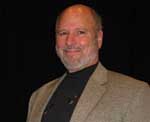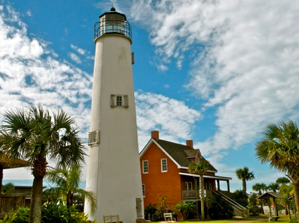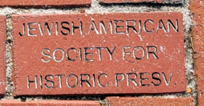By Jerry Klinger

Touristing — better known as cultural travel, especially historical travel to see the places of events, and meaning to the American experience, preferably without resentful teenagers — is great. A fun thing to do in Florida is to visit historical lighthouses. There are big ones, short one, white ones, red ones, and striped ones like candy canes. There are short ones, 7’, and tall ones 191’ – that is a lot of stair climbing. Some are out in the middle of dangerous nautical areas that only wildlife and wayward mariners ever get to, like Alligator Reef Light in the Keys. Others are ashore, adjacent to magnificent beaches and very accessible. More than a few have become museums.
Alligator Reef Light is not easy to get to. It sits on a dangerous offshore coral reef. From the name you might assume the primary visitors are Alligators of which there are plenty in every Florida man-made lake behind any house.
Alligator Reef was named for the U.S.S. Alligator, an anti-piracy schooner out of Key West that went aground on the Reef in 1822. They stripped her of everything possible and blew the ship up so pirates could not reclaim her. On the other side of the same coin, Hen and Chickens Shoal light makes one wonder. Did a group of chickens commandeer a boat escaping Colonel Sanders when the bearded one showed up at their chicken coop, only they got stuck on a shoal? What was their fate…don’t ask. Kentucky Fried Chicken does not answer emails.
Of the 49 lighthouses in Florida, 25 are still on active duty shinning their nightly beacons of warning to ward off errant ships. The first lighthouse goes back to Spanish days in St. Augustine, 1720s. It’s long gone.

Lighthouse viewing is a fun beach adventure. Some Lighthouses are museums and climbable – from the inside. Outdoor scaling is not encouraged. Some have bricks/pavers that you can buy to support the lighthouse’s preservation effort. Cape St. George Lighthouse in the Panhandle area of Florida just outside of Apalachicola Bay is one.
St. George Light dates from 1833. St. George Light and nearby Dog Island Light, 1839, were vital navigational aids. Threading the needle to enter Apalachicola Bay was extremely dangerous.
In the 1830s, Apalachicola was a major cotton port and the third busiest on the Gulf of Mexico. Today, a large chunk of Florida’s Oysters come from the Bay.
The Lighthouses did not last long. The Hurricane of 1850, a real big one, took both St. George and Dog Island Lights out.
St. George Light was rebuilt in 1851-52. It toppled into the Gulf in 2005, after 153 years of service.
A group of local historical activists did the impossible and had the St. George Light rebuilt and opened in 2008. A museum is attached. The museum sells vanity bricks with the donor’s name on them. The bricks are placed in the walkways.
 I bought a brick. A week ago, I received an email about the brick. Exciting.
I bought a brick. A week ago, I received an email about the brick. Exciting.
“Your paver has now been installed in Patch 42. This is the 6th patch on the South path to the West side of the Keeper’s Museum and Giftshop as you walk toward the beach.”
I bought the brick for two reasons. First to support the historical preservation effort. The second reason was to bewilder land lubbing travelers who will see the word Jewish and ask themselves is there a Jewish story here. “We thought the Jews lived in Miami.”
Don Harrison, editor emeritus of San Diego Jewish World, answers it better: “There is a Jewish story everywhere.”
The first Jew to live in Florida trace back to Spanish control, Antonio Martinez Carvajal was a Harbor Pilot in the St. Augustine area, 1565. He like others after him may or may not have been 100% kosher Jews. They were Crypto-Jews, Jews who were forced or chose under duress to convert to Catholicism but remained secretly Jewish in their private customs and ceremonies — a very dangerous activity. The Inquisition kept a close eye on former Jews. Torture and burning at the stake, the Auto-da-Fe, were never far away for backsliders.
Organized public Jewish life was impossible under Spanish rule.
In 1819-1820, Florida was sold by Spain to the United States. Jews were finally able to openly live in the “Sunshine State.” The St. Augustine community grew to a handful of Jewish merchants. Raphael Moses, a fifth generation South Carolinian Jew tried his luck there. It did not work out. He eventually moved to Columbus, Georgia and became the father of the Georgia Peach industry.
Not until 1898 did the St. Augustine’s Jewish community grow large enough to build their first house of worship.
The title for the first permanent Jewish House of Worship in Florida belongs to another small Jewish community to the west, in Pensacola. The second Jewish historical marker that the Jewish American Society for Historic Preservation (JASHP) ever did marked the site of Temple Beth El, 1876.
Why Pensacola?
Jews relocated from New Orleans to British West Florida when New Orleans was transferred to the Spanish in 1762 from Louisiana’s colonial founders, the French. The changing landscape of European wars traded American territory like cards. Jews understood full well, it was not healthy to live under Spanish rule. The French did not enforce their Code Noir, the Black Code, against Jews much. The Spanish were different. They had a thing about Jews living in their territories.
Jews arrived in West Florida, the area from Apalachicola to Pensacola with the British session in 1763.
It was, however, the American purchase of Florida from the British in 1819 that got Jewish presence going.
Jews settled and opened commercial enterprises across Northern Florida by the 1830s. They did not venture to deep South Florida. Few people wanted to live in the malarial, gator infested swamps of Dade County (Miami).
Central Florida is about 150 miles S.E. from the JASHP brick at Cape St. George Light. An incredible, little known, Jewish story happened near the tiny village of Micanopy.
JASHP placed a State of Florida marker in the little town of Micanopy for Moses Levy.
The text reads:
MOSES ELIAS LEVY
“Moses Elias Levy (1782-1854), a Moroccan born Jewish merchant, came to Florida after its cession from Spain to the United States in 1821. Before his arrival, Levy acquired over 50,000 acres in East Florida. In 1822, Levy began development on Pilgrimage Plantation, just northwest of the future town of Micanopy. The plantation’s main commodity was sugar cane, which Levy had reintroduced to Florida. Levy and his partners, including the Florida Association of New York, helped to draw Jewish settlers to the area with the goal of creating a refuge for oppressed European Jews in a communitarian settlement, the first on U.S. Soil. Levy’s efforts sparked significant economic development, spurring the growth of Micanopy from a small trading post to a bustling town. Pilgrimage was destroyed in 1835 during the Second Seminole War, but Levy’s reform efforts continued. He promoted free public education and served as one of the territory’s first Education Commissioners. He was also a vigorous advocate for the gradual abolition of slavery and the humane treatment of enslaved people. Levy was the father of David Levy Yulee, one of the first U.S. Senators from Florida and the first U.S. Senator of Jewish heritage in American History.”
Jews like to claim David (Levy) Yulee was the first Jewish U.S. senator. That is a bit of a stretch. To get elected he had to change his name from Levy to Yulee. Levy was too Jewish. Levy and his son became estranged. Levy was an abolitionist. Yulee was an ardent slave holder. Yulee rejected his heritage. He married a nice non-Jewish girl. Years later, he arranged for their burial in Washington, D.C., under a Cross. Yulee had converted.
Jewish life in Florida never became big until the 20th century. Shvitizing vs. air conditioning was a big factor. The Fontainebleau hotel, South Beach, easy rail, and air travel from New York helped a lot.
Jews had a big impact in Key West and the Cuban revolution against the Spanish. That is another story a long way away from JASHP’s brick at the Cape St. George Lighthouse.
Maybe I’ll tell it another time.
*
Jerry Klinger is the President of the Jewish American Society for Historic Preservation, www.JASHP.org
My husbands grandmother was Rosalie Levy born in Thomasville Georgia. The family ran the local Mercantile there in the mid 1800’s and it became the local department story in later years. I wonder if she is a descendant of Moses Elias levy?